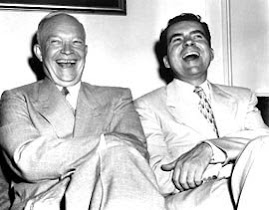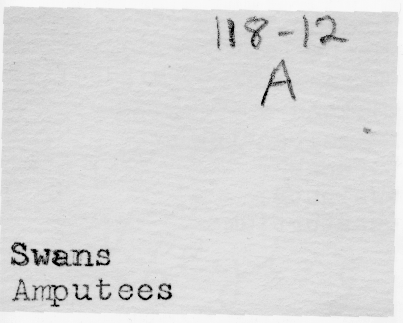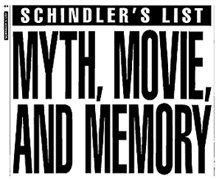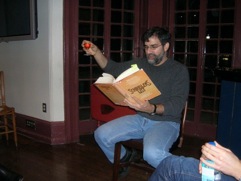
At the beginning of 1996 I put out the word, by email and word of mouth, to Penn alumni that I was ready to convene a group of university alumni to discuss modern poetry by email. No fee, no credit, just talk. About a hundred people wrote me to say they wanted to try this. I made a huge listserv and we called our project "Alumverse." We were supposed to begin on some even date, January 15 or February 1, but on January 7 the entire east coast was hit by an enormous snowstorm and for several days everyone was stuck at home. And for the first time in the relatively new internet age (by which I mean, the moment in the 90s when a bare majority, but nonetheless a majority, had email accounts and checked for messages regularly. On January 7 everyone logged on - many to try to do work even though away from the office. And, going a big stir-crazy, they began writing me,
Why don't we begin talking about the poetry now? Why wait? So we began.
Hundreds of emails were sent and received in those first few snowed-in days.
We began by talking about Emily Dickinson, and soon moved to William Carlos Williams, Lorene Niedecker, Gertrude Stein, Wallace Stevens, and so on.
Within a few weeks the group of 100 had grown to about 160. By the end of February, when we were supposed to stop, the Alumversers refused to do so. They would go on without me if they must. They wanted to maintain the listserv. They wanted to pick their own poems for discussion. I stayed on and we talked for the entire year of 1996, and even a little into 1997.
By August 7, 1996,
USA Today had caught wind of this and ran a story.
The Philadelphia Inquirer wrote about us too:
Elsie Sterling Howard said she was fascinated last fall when University of Pennsylvania English professor Al Filreis told her about his use of e-mail to stimulate out-of-the-classroom discussions among the students in his introducto ry poetry class.
Howard, a 1968 graduate who heads Penn's General Alumni Association, had only one question: Had he ever considered trying it with alumni?
``Absolutely,'' Filreis replied. ``We can do it.''
Now, 159 Penn grads from across the country and even abroad are taking a virtual version of Filreis' popular poetry seminar.
They're logging on to read, ruminate and post their thoughts on works by everyone from Emily Dickinson to Allen Ginsberg.
``This is not a course,'' said Filreis. ``It's a conversation.''
The class roster includes psychiatrists, teachers, fund-raisers and graduate students in forestry. It has attracted some who spent their days at Penn in the 1950s, and some who received their diplomas last year. The only thing they have in common is that they once attended Penn. Filreis addresses them all as: ``Dear Alumversers."
The discussion was always at a high level, and always chaotic, and absolutely characterized by good will. There were many disagreements but they became part of the personality of the group. You'd think that among 149 others individuals would not easily distinguish themselves (being just an email address to those on the other end). But there emerged at least 50 or 60 very clearly defined characters.
Over the years since Alumverse, I've met most of these people. Many have visited me at the Kelly Writers House. Some merely stop by when they are on campus. Others make special visits. The children of several have become my regularly matriculated undergraduate students. A few have become donors (yes, the Writers House needs donated funds to keep going). How gratifying that the basis of this virtual community (don't love the phrase but that's what this was) was an interest in modern verse. Most hadn't any idea about poetry and poetics but they were looking for a challenge. I did some work keeping it all going, focusing everyone on the poems themselves, but not as much work as you might think. Alumverse ran itself after a while. And of course long digressions are possible in email. Those who didn't want to follow a digression simply deleted said digressions. (At one point there was a month-long digression on campus radicalism circa 1968. This was so compelling that Penn's alumni magazine, the
Gazette, ran an article just about this part of the discussion.)
When we finally disbanded, almost everyone wrote long farewells. Here I quote from that of Joe the dentist from Atlantic City:
So the alumverse arrived at a proper time for me as, in retrospect, most things do. Though I've long had an interest in poetry (God knows there's enough books of poetry around here), I've never felt I "understood" it very well. So I appreciated this opportunity to have a renewed and revamped sense for it and of it. I'm still not sure how well I understand it, but I'm not sure of a lot of things; I try not to let it get in my way. You may have noticed. I am sure there is no mention of the words "poet" or "poetry" in the entire 26 volumes of the Warren Commission Report (I've done the search), but let's face it, poetry's tough. Consider this statement of Faulkner's:
"I'm a failed poet. Maybe every novelist wants to write poetry first, finds he can't and then tries the short story which is the most demanding form after poetry. And failing at that, only then does he take up novel writing."
So I send a virtual hug to all the versers who filled my mailbox, assuaging the ultimate loneliness of the long distance scholar, from Adam, who showed he belongs at a think tank, to Zumbro, who'll let me call her Susanne, and all the ones in between, Evan who's taken to hanging around bookstores where you can usually find me, and Peter who spammed us in the only netiquettally appropriate way, and Robin who has maybe had that baby by now, and John Kim for whom I established a folder in my hard drive, and Marc who drove me crazy by always quoting the entire text he was responding to but I always scrolled down to get to his words because they were worth it, and TheSteven never judging us harshly as he invented poet bytes and happened upon a cyber rent in Adam's heart, and John Norton a real poet whose anthology I own, and Doc Gonzo the night the graphic arrived I knew he has poetry in his soul than he hasn't dreamt of, yet, and Andrea who like me wants it both ways, and Carole sweet and shy came to the union took my phone number and never called story of my life, and Ron who probably now fondly remembers the blizzards we began with, and Edward who wore a suit just to be around us go figure, and Marguerite who....
You can read Joe's entire valediction
here. A general
Alumverse web page, although old, describes the project and provides links to the newspaper articles mentioned above and some other materials. Pardon a few dead links. The photo above was taken during an alumni reunion on campus, at a little tent marked "Alumversers." There a few of us met and we had a "union," as someone dubbed it. It couldn't have been a
reunion since none of us had yet met when we met there. "Long live the union!" shouted Conni Bille.
 Funny, yes. But I want to ask: why is it said that a poet "places" a comma between words - placing implying force, artificiality, conscious construction - while the traditional quatrain itself doesn't entail placement. Aren't they both placings? They achieve effects, one disruptive of flow and the other sustaining it.
Funny, yes. But I want to ask: why is it said that a poet "places" a comma between words - placing implying force, artificiality, conscious construction - while the traditional quatrain itself doesn't entail placement. Aren't they both placings? They achieve effects, one disruptive of flow and the other sustaining it.

















































 "I teach horizontally, meaning that while I might begin with a fixed idea of what I'm going to teach that day, I let it drift rhizomatically way off topic, often pulling it back when it gets too far. I rely on non-fixed materials to teach this way; the whole world is at my fingertips. Should I go off on a tangent about John and Rauschenberg and their love relationship as expressed in Rauschenberg's bed, an image of that bed is always a click away. From there, we can head anywhere into the non-fixed universe, be it film, text or sound. And of course, that always takes us elsewhere. As Cage says, 'We are getting nowhere fast.'"
"I teach horizontally, meaning that while I might begin with a fixed idea of what I'm going to teach that day, I let it drift rhizomatically way off topic, often pulling it back when it gets too far. I rely on non-fixed materials to teach this way; the whole world is at my fingertips. Should I go off on a tangent about John and Rauschenberg and their love relationship as expressed in Rauschenberg's bed, an image of that bed is always a click away. From there, we can head anywhere into the non-fixed universe, be it film, text or sound. And of course, that always takes us elsewhere. As Cage says, 'We are getting nowhere fast.'" 

 that anyone has yet got the imaginative measure of that terrifying day six years ago. Certainly our Tolstoy has not crawled out of the rubble. The closest we have, Don DeLillo, succeeded as an essayist-journalist ("In the Ruins of the Future: Reflections on Terror and Loss in the Shadow of September,” Harper’s, December 2001) but, to my mind, failed as a novelist ("Falling Man"). One reason, perhaps, is that the remembered emotion was instantly buried under a pile of cultural junk.' - Tod Gitlin in his review of Susan Faludi's The Terror Dream (written for
that anyone has yet got the imaginative measure of that terrifying day six years ago. Certainly our Tolstoy has not crawled out of the rubble. The closest we have, Don DeLillo, succeeded as an essayist-journalist ("In the Ruins of the Future: Reflections on Terror and Loss in the Shadow of September,” Harper’s, December 2001) but, to my mind, failed as a novelist ("Falling Man"). One reason, perhaps, is that the remembered emotion was instantly buried under a pile of cultural junk.' - Tod Gitlin in his review of Susan Faludi's The Terror Dream (written for 





























